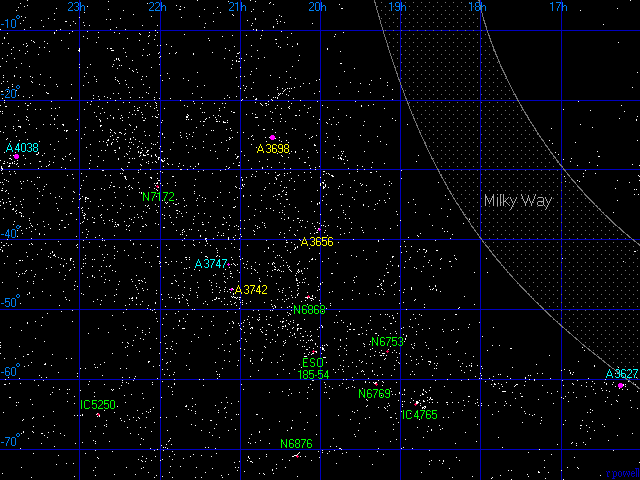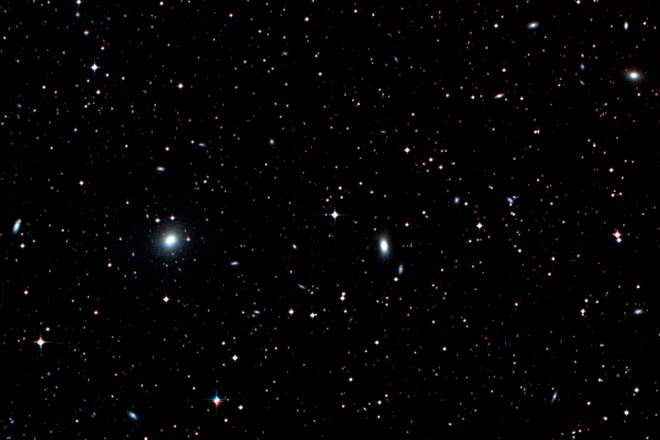
The Pavo-Indus Supercluster is not regarded as a major supercluster. It is not a particularly dense concentration of galaxies and it doesn't contain any very rich clusters of galaxies. This map below shows the brightest galaxies (from the Principal Galaxies Catalogue) in this region of the sky. The Pavo-Indus Supercluster is faintly visible as a curving wall of galaxies that connects to the rich A3627 cluster and ultimately to the Centaurus supercluster.

Below is a list of clusters of galaxies in the vicinity of the Pavo-Indus Supercluster. The three Abell clusters within this supercluster are A3656, A3698 and A3742. They are not impressive clusters of galaxies. The most important cluster in this region of the sky is the major A3627 cluster which dominates this part of the universe (see the page on the Centaurus supercluster for more information).
1 2 3 4 5 6 7
Abell Equatorial Redshift Distance Rich Notes
Number Coordinates z Mly
RA Dec
A3627 16 15.5 -60 54 .0145 200 1 Norma cluster
A3656 20 00.5 -38 32 .0178 245 0
A3698 20 36.0 -25 17 .0188 260 1
A3742 21 06.7 -47 09 .0152 210 0
A3747 21 08.7 -43 30 .0298 410 0 background cluster
|
Below are some other prominant groups of galaxies in this region. Notice that there are two separate groups of galaxies which are commonly called the Pavo cluster. The IC4765 group is the larger of the two Pavo clusters and it may possibly be a richer group than the three Abell clusters within the supercluster.
1 2 3 4 5 6 7
Group Equatorial Redshift Distance Rich Notes
Name Coordinates z Mly
RA Dec
IC4765 18 47.7 -63 19 .0149 205 Pavo cluster
NGC6753/IC4837A 19 09.7 -55 07 .0103 145
NGC6769/IC4845 19 17.8 -60 31 .0134 185
ESO185-54 20 03.4 -55 56 .0144 200
NGC6868 20 09.8 -48 15 .0095 130 Telescopium cluster
NGC6876 20 18.5 -70 53 .0127 175 Pavo cluster
NGC7172/IC5156 22 02.2 -32 24 .0089 125
IC5250/NGC7329 22 47.5 -65 06 .0108 150
|
Column 1: The name/number of the cluster or group.
Column 2: The Right Ascension for epoch 2000.
Column 3: The Declination for epoch 2000.
Column 4: The redshift of the cluster.
Column 5: The distance in millions of light years assuming H=70km/s/Mpc.
Column 6: The 'richness' class of the cluster (for Abell clusters only).
Column 7: Additional names and notes.
References:
Abell G, Corwin H, Olowin R, (1989), A catalogue of Rich Clusters of Galaxies,
Astrophys J Supp, 70, 1.
Struble M, Rood H, (1999), A compilation of redshifts and velocity dispersions for
ACO clusters, Astrophys J, 125, 35.
Fouqué P, Gourgoulhon E, Chamaraux P, Paturel G, (1992), Groups of Galaxies within
80 Mpc, Astron Astrophys Supp, 93, 211.
Garcia A, (1993), General study of group membership. II. Determination of nearby groups.
Astron Astrophys Supp, 100, 47.
Giuricin G, Marinoni C, Ceriani L, Pisani A, (2000), Nearby optical galaxies: selection
of the sample and identification of groups. Astrophys J, 543, 178.
Very little information has been written about the Pavo-Indus supercluster. It is not considered to be an important supercluster. Most of the early research showed that the supercluster was part of a nearby wall of galaxies which connects to the major A3627 galaxy cluster and the Centaurus supercluster. A Fairall submitted evidence in support of this view in a paper in 1988.
More recently H di Nella, W Couch, G Paturel and Q Parker surveyed this region of the sky in 1996 to see if the Pavo-Indus supercluster was connected to the Perseus-Pisces supercluster. In their paper, published at the same time, they concluded that it was not.

Above - the cluster A3742 which lies in the middle of the Pavo-Indus supercluster. This is a typical example of an Abell cluster with a richness class of 0. About twenty galaxies can be seen in this picture (visible as fuzzy oval patches) but most of them are very hard to distinguish from the foreground stars. The two brightest galaxies here are ESO 286-49 (centre) and NGC 7014 (left).